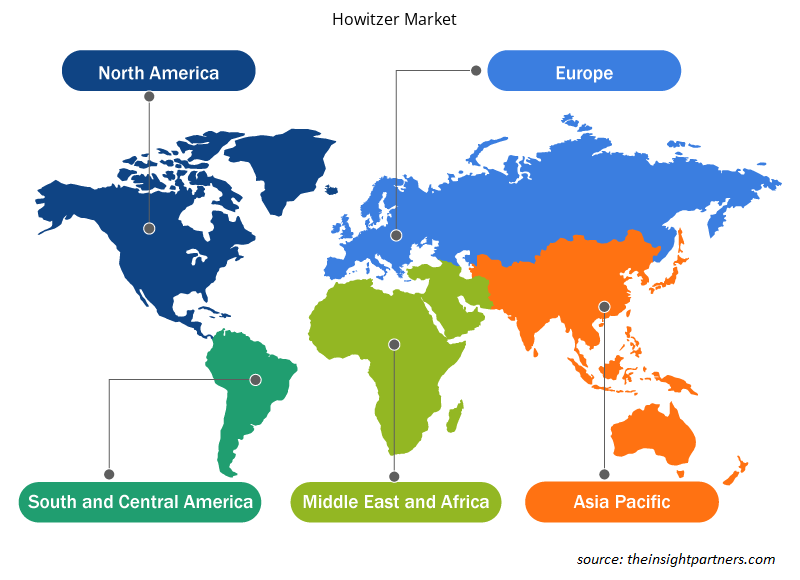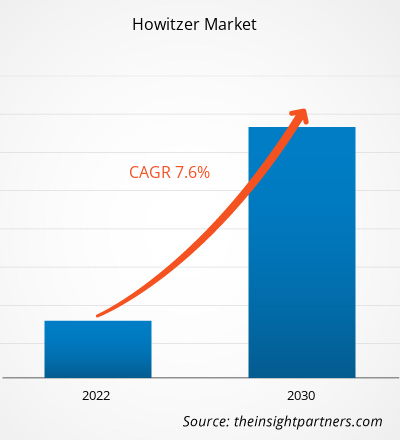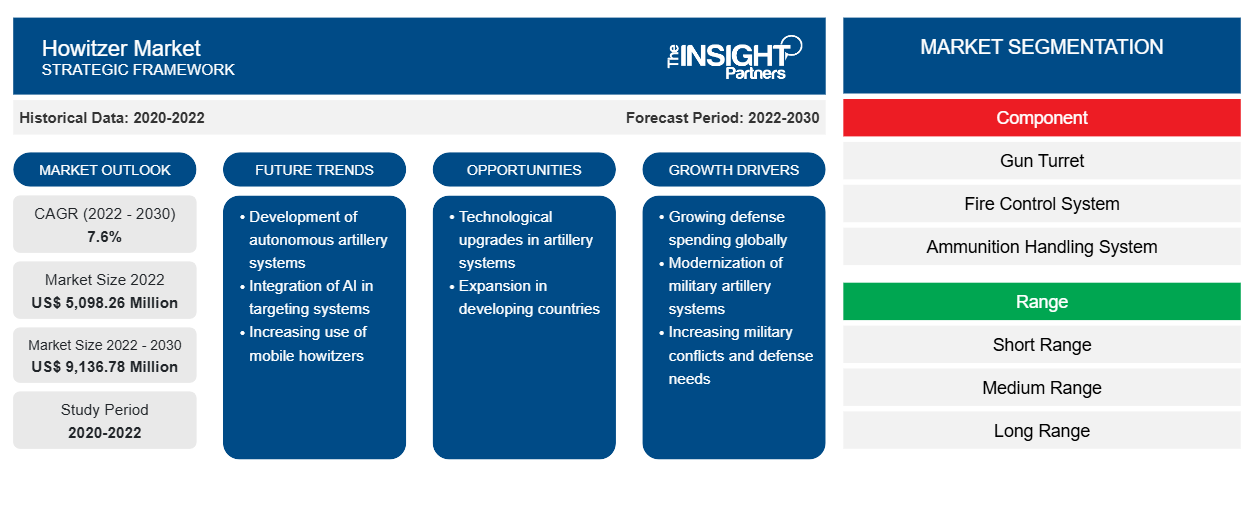[Informe de investigación] Se espera que el tamaño del mercado de obuses crezca de US$ 5.098,26 millones en 2022 a US$ 9.136,78 millones en 2030; se estima que registrará una CAGR del 7,6% de 2022 a 2030.
Perspectiva del analista:
El mercado de obuses ha experimentado un crecimiento tremendo en los últimos años. Uno de los principales factores que impulsan el crecimiento del mercado es el aumento del gasto militar para la adquisición de tecnologías de guerra en diferentes regiones. Las tendencias del mercado de obuses incluyen el creciente desarrollo de sistemas de artillería autopropulsada. Los sistemas de artillería autopropulsada se utilizan actualmente en las guerras de los principales países, como Rusia-Ucrania, Estados Unidos-Irán, Israel-Palestina y China-Taiwán. Los fabricantes de obuses se centran principalmente en el desarrollo de productos innovadores para seguir siendo competitivos en el mercado.
Descripción general del mercado:
El alcance del informe de mercado de obuses cubre América del Norte (EE. UU., Canadá y México), Europa (España, Reino Unido, Alemania, Francia, Italia y el resto de Europa), Asia Pacífico (Corea del Sur, China, India, Japón, Australia y el resto de Asia Pacífico), Medio Oriente y África (Sudáfrica, Arabia Saudita, Emiratos Árabes Unidos y el resto de Medio Oriente y África) y América del Sur y Central (Brasil, Argentina y el resto de América del Sur y Central). Es probable que el mercado de obuses registre un crecimiento saludable en los próximos años. Sin embargo, el mercado está moderadamente consolidado con la presencia de un número limitado de actores que operan en diferentes regiones. Además, algunos de los países han estado impulsando sus inversiones militares para adquirir obuses autopropulsados para reemplazar sus viejos y obsoletos obuses y se operan con los costos operativos más altos.
Las tensiones constantes entre países como Rusia-Ucrania, China-Taiwán, Israel-Palestina, Estados Unidos-China, India-Pakistán e India-China. Además, esto también se debe a las crecientes competencias geopolíticas entre los diferentes países para fortalecer sus respectivas fuerzas armadas, para lo cual están adquiriendo tecnologías de guerra avanzadas y agregando más fuerza a sus respectivas fuerzas armadas. Estos factores han estado impulsando el despliegue de obuses y vehículos obuses en mayor número, lo que está generando aún más la necesidad de sistemas de obuses en diferentes regiones.
Personalice este informe según sus necesidades
Obtendrá personalización en cualquier informe, sin cargo, incluidas partes de este informe o análisis a nivel de país, paquete de datos de Excel, así como también grandes ofertas y descuentos para empresas emergentes y universidades.
- Obtenga las principales tendencias clave del mercado de este informe.Esta muestra GRATUITA incluirá análisis de datos, desde tendencias del mercado hasta estimaciones y pronósticos.
Conductor del mercado:
El creciente número de contratos para sistemas de obuses impulsa el crecimiento del mercado de obuses
Los fabricantes que operan en el mercado de sistemas de artillería se centran en gran medida en colaborar con diferentes gobiernos y fuerzas armadas para comprender sus respectivas demandas y ofrecerles soluciones adecuadas. Las fuerzas militares de varios países están otorgando numerosos contratos a fabricantes de sistemas de artillería para adquirir varios sistemas de comunicación, vigilancia y navegación. Además, las fuerzas de defensa de diferentes naciones están invirtiendo sustancialmente en la adquisición de sistemas de artillería como artillería de cohetes, morteros y obuses. Los sistemas de artillería son confiables para derribar objetivos de corto, mediano y largo alcance. Permiten a las fuerzas armadas facilitar el disparo remoto mejorado en plataformas terrestres o navales.
La mayoría de las fuerzas armadas de los países han invertido mucho en la adquisición de sistemas de artillería. A continuación se mencionan algunos ejemplos:
- En diciembre de 2023, la Agencia Estatal de Armamento de Polonia anunció que había comprado obuses K9 de Corea del Sur como parte del acuerdo de 2.600 millones de dólares con Hanwha Defense.
- En noviembre de 2023, BAE Systems ganó un contrato por valor de 63 millones de dólares del Departamento de Defensa de EE. UU. para producir obuses autopropulsados Paladin y vehículos transportadores de municiones.
- En septiembre de 2023, el Ejército indio aprobó una propuesta para comprar 400 unidades de obuses por valor de 48 millones de dólares a empresas indias.
- En diciembre de 2022, el Ministerio de Defensa de la India emitió una solicitud de propuesta a L&T para producir 100 unidades de obuses K9 a través de Hanwha Defense Technology.
El creciente número de contratos y acuerdos para adquirir fuerzas militares avanzadas para combatir la guerra terrestre es un impulsor importante del mercado de obuses a nivel mundial.
Análisis segmental:
El análisis del mercado de obuses se ha llevado a cabo considerando los siguientes segmentos: componente, alcance y tipo. Según el componente, el mercado se segmenta en torreta de cañón, sistema de control de fuego, sistema de manejo de municiones, sistema auxiliar y otros. El segmento del sistema de control de fuego tuvo la mayor participación de mercado de obuses en 2022. El segmento representó el 31,9% de la participación de mercado y se espera que tenga el 34,7% de la participación de mercado para 2030. Un sistema de control de fuego es uno de los componentes más caros e importantes de cualquier sistema de artillería . Muchos países han estado invirtiendo una parte importante de su respectivo gasto militar para adquirir sistemas avanzados de control de fuego para sus artillerías existentes. La creciente adquisición de nuevos sistemas de artillería por parte de diferentes países y la creciente modificación de los sistemas de artillería existentes se encuentran entre los factores que impulsan la demanda de sistemas de control de fuego en diferentes regiones. Por ejemplo, en septiembre de 2023, Elbit Systems Ltd ganó un contrato por valor de 200 millones de dólares para suministrar una solución C4I a batallones de artillería y un sistema de contraataque de fuego hostil (HFCA) a un cliente no revelado en la Unión Europea.
Análisis regional:
El mercado de obuses de América del Norte se valoró en 1.678,30 millones de dólares en 2022 y se proyecta que alcance los 3.016,69 millones de dólares en 2030; se espera que registre una CAGR del 7,6% durante 2022 a 2030. América del Norte cuenta con la presencia de algunos fabricantes importantes de sistemas de obuses, como BAE Systems Plc, Saab AB, General Dynamics Ordnance and Tactical Systems y Northrop Grumman Corporation, que tienen sus respectivas instalaciones de producción en diferentes partes de la región y siguen atendiendo la demanda de sistemas de obuses desde sus respectivas instalaciones. Estados Unidos representó la mayor participación en el mercado de obuses en América del Norte, debido a la presencia de los principales fabricantes de obuses y al mayor gasto militar a nivel mundial.
Perspectivas regionales del mercado de obuses
Los analistas de Insight Partners explicaron en detalle las tendencias y los factores regionales que influyen en el mercado de obuses durante el período de pronóstico. Esta sección también analiza los segmentos y la geografía del mercado de obuses en América del Norte, Europa, Asia Pacífico, Oriente Medio y África, y América del Sur y Central.

- Obtenga los datos regionales específicos para el mercado de obuses
Alcance del informe de mercado de obuses
| Atributo del informe | Detalles |
|---|---|
| Tamaño del mercado en 2022 | US$ 5.098,26 millones |
| Tamaño del mercado en 2030 | US$ 9.136,78 millones |
| CAGR global (2022-2030) | 7,6% |
| Datos históricos | 2020-2022 |
| Período de pronóstico | 2022-2030 |
| Segmentos cubiertos | Por componente
|
| Regiones y países cubiertos | América del norte
|
| Líderes del mercado y perfiles de empresas clave |
|
Densidad de actores del mercado de obuses: comprensión de su impacto en la dinámica empresarial
El mercado de obuses está creciendo rápidamente, impulsado por la creciente demanda de los usuarios finales debido a factores como la evolución de las preferencias de los consumidores, los avances tecnológicos y una mayor conciencia de los beneficios del producto. A medida que aumenta la demanda, las empresas amplían sus ofertas, innovan para satisfacer las necesidades de los consumidores y aprovechan las tendencias emergentes, lo que impulsa aún más el crecimiento del mercado.
La densidad de actores del mercado se refiere a la distribución de las empresas o firmas que operan dentro de un mercado o industria en particular. Indica cuántos competidores (actores del mercado) están presentes en un espacio de mercado determinado en relación con su tamaño o valor total de mercado.
Las principales empresas que operan en el mercado de obuses son:
- BAE Systems Plc
- Elbit Systems Ltd
- Avibras
- Grupo Hanwha
- Grupo RUAG
Descargo de responsabilidad : Las empresas enumeradas anteriormente no están clasificadas en ningún orden particular.

- Obtenga una descripción general de los principales actores clave del mercado Howitzer
Análisis de los jugadores clave:
El informe del mercado de obuses incluye los perfiles de empresas como BAE Systems Plc, Elbit Systems Ltd, Avibras, Hanwha Group, RUAG Group, IMI Systems, General Dynamics, ST Engineering, Denel SOC Ltd y Saab AB. Estos son los principales actores del mercado, debido a la cartera de productos diversificada que ofrecen.
Desarrollos recientes:
El pronóstico del mercado de obuses puede ayudar a las partes interesadas a planificar sus estrategias de crecimiento. Las estrategias inorgánicas y orgánicas, como lanzamientos de productos, fusiones y adquisiciones, son ampliamente adoptadas por las empresas que operan en el mercado de obuses. Por ejemplo,En julio de 2023, Avibras Indústria Aeroespacial firmó un memorando de entendimiento con la empresa saudí SCOPA Defense para desarrollar y fabricar equipos de defensa avanzados. La asociación tiene como objetivo crear nuevos puestos de trabajo, garantizar la soberanía de Arabia Saudita y contribuir al sector privado. SCOPA tiene como objetivo estimular otros sectores, como el de equipos industriales, comunicaciones y tecnología de la información, mediante la creación de industrias de defensa privadas. Estas iniciativas estratégicas catalizan el crecimiento del mercado de obuses desde la perspectiva de los proveedores.
- Análisis histórico (2 años), año base, pronóstico (7 años) con CAGR
- Análisis PEST y FODA
- Tamaño del mercado, valor/volumen: global, regional y nacional
- Industria y panorama competitivo
- Conjunto de datos de Excel
Informes recientes
Testimonios
Razón para comprar
- Toma de decisiones informada
- Comprensión de la dinámica del mercado
- Análisis competitivo
- Información sobre clientes
- Pronósticos del mercado
- Mitigación de riesgos
- Planificación estratégica
- Justificación de la inversión
- Identificación de mercados emergentes
- Mejora de las estrategias de marketing
- Impulso de la eficiencia operativa
- Alineación con las tendencias regulatorias





















 Obtenga una muestra gratuita para - Mercado de obuses
Obtenga una muestra gratuita para - Mercado de obuses